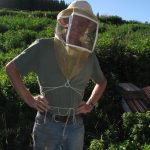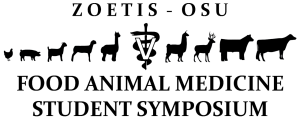Liquid Nitrogen Ice Cream

Ed Colby
Get On Board!
coloradobees1@gmail.com
Liquid nitrogen is very cold – between -320° and -346°F. And it’s not cheap, but Katie Lee told me you never have to waste any, because you can always use it to make ice cream!
Katie flew into Grand Junction, Colorado, where I picked her up. After breakfast we stopped off at a liquid nitrogen filling station. She unzipped her suitcase and pulled out an insulated aluminum 30-liter vessel called a “Dewar.” Katie said it got some attention from the TSA folks.
The cheerful Airgas attendant said he’d seen a lot of things but never a Dewar packed into a suitcase. He filled it with liquid nitrogen, and I tied it onto the bed of the pickup. Katie warned me beforehand that you don’t travel with liquid nitrogen in a passenger car. “What if we got in a wreck?” she said.
Katie came to the Colorado State Beekeepers Association (CSBA) bee college from the University of Minnesota to teach us about hygienic bees. Hygienic honey bees remove Varroa mites from brood cells and from each other, so this is a very good trait for your bees to have! They also remove from the hive diseased material, including chalk brood and American Foulbrood (AFB) deposits.
On the way back to the farm in New Castle, we stopped off at Paul’s beeyard. Katie and I opened up two hives, and from each we removed a frame of sealed brood. Into this solid or nearly solid brood patch we inserted the end of a four-inch-long chunk of three-inch-diameter plastic PVC pipe. We stuck the PVC pipe down into the brood, twisting and pushing it all the way against the plastic foundation. We then laid the frame horizontally on top of a hive lid, with the PVC pipe sticking up out of it.
Next we poured a little liquid nitrogen into the pipe, to check for leaks. Finding no leaks, we proceeded to fill the pipe with nitrogen. In a few minutes the liquid nitrogen in the pipe boiled off, leaving behind a three-inch circle of frozen dead brood. Done for the day! Now we had to wait 24 hours to see how efficiently the bees cleaned out the dead brood.
When we came back the following day, with the entire bee college in tow, we examined these same frames of brood. In one, the bees had removed virtually all of the dead brood, indicating excellent hygienic behavior. In the other, only half the dead brood had been removed. Not so good!
After Katie showed the results of the test to the bee college participants, she demonstrated how she froze the brood to set up the test. So now we had two more frames with frozen brood. She and I came back the following day to see what we might learn. Results: two more frames of dead brood 100 percent or nearly 100 percent cleaned out, indicating excellent hygienic traits.
We were on a roll! Next we did tests on two hives at the farm. Results: two more hygienic hives. These bees came from a California breeder who each year sells me queens that are prolific and hardy, but I had never before gathered data that might document their resistance to Varroa mites. Since Katie explained that only about ten percent of hives carry the hygienic trait, my two tests gave me reason to believe that many of my California queens might produce hygienic offspring.
To summarize, five of six colonies tested positive for hygienic behavior, including three of four belonging to Paul. Since Paul’s drones dominate the landscape in this part of Colorado, and since he buys queens that are purportedly hygienic, we may have something going here.
This is a very big deal. Of the plethora of challenges facing our little darlings, mites are one problem that we beekeepers, individually, can impact. We can’t necessarily control our bees’ access to good forage, or their exposure to chemicals, but we can and should reduce their stress from Varroa.
Meanwhile, as Katie gave her demonstration to half the attendees, Paul lectured in front of the honey house to the other half. He showed off frames of AFB, European Foulbrood (EFB) and chalk brood. You can’t get this kind of education out of a book. With AFB, you have to see it, touch it, smell it. Once you recognize AFB, you don’t have to send off samples to some bee lab to confirm your diagnosis. You’ll know. I can sometimes smell AFB from ten feet away. You need to be able to identify AFB, and you need to deal with it. There’s more than one way. But recognizing it is the first step.
After all this learning under a hot June afternoon sun, we clung to the shade next to the honey house. As Katie made liquid nitrogen ice cream, I sensed there was no way I was going to herd these wilted beekeepers 300 yards across the property to a classroom set up for a CSBA general meeting. So I stood up on a chair right there in the shade and called the meeting to order.
It was a rewarding day, an informative bee college, a spectacular banquet following. The gal Marilyn and I got to have Katie with us at the farm for the weekend. Damn! Life can be good.
Ed Colby practices beekeeping in Aspen Mountain, Colorado, where he lives with his partner, Marilyn.









